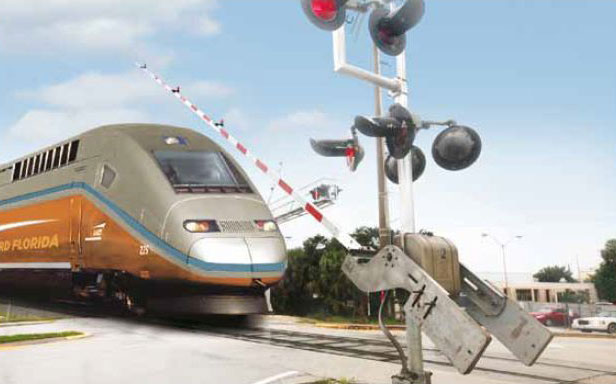
VERO BEACH — Former Vero Beach City Councilmen Brian Heady and Ken Daige, and Indian River County Chamber of Commerce Executive Director Penny Chandler, are among those who have volunteered to tackle the traffic, safety and economic implications of 32 All-Aboard Florida trains a day speeding through Vero Beach at up to 110 miles per hour.
In September, the City Council voted to form an ad-hoc High Speed Rail Commission because Vero has seven crossings that it will need to protect, potentially at taxpayer expense of up to $500,000 per crossing, before the trains start blasting through Vero en route between Miami and Orlando.
The trains will not be stopping for passengers in Vero.
In addition to Chandler, Daige and Heady, others who applied to be on the commission are Don Croteau of the city’s planning and zoning board, Scott Stradley of Main Street Vero Beach and Kieran Moylan.
All-Aboard spokesman Rusty Roberts has agreed to serve as a non-voting member.
Stradley, a local CPA, said he volunteered for the rail commission to help get to the bottom of the issue.
He noted that former Vice Mayor Tracy Carroll pushed hard to set up the commission and that he’s “glad it didn’t get dropped.”
“There’s a lot that we don’t know at this point in time,” Stradley said.
And time is running out, as All-Aboard Florida expects to have the trains operational sometime in the next couple of years.
“I’m looking forward to getting all the facts. If we have to spend a lot of money, we need to really know what’s going on, and I’m not sure we need to spend any money. We need to find the facts and make a rational decision based upon good information.”
Vero Beach residents and tourists will not have the privilege of actually boarding the trains unless they want to drive to the nearest stop in downtown West Palm Beach, but they will have to wait in traffic for them to pass a couple of times an hour.
Stradley said Main Street hasn’t taken a position on All-Aboard Florida’s plan yet, but he laid out the major concerns.
“We have the tracks, particularly from Main Street right there at 12th, Royal Palm, 24th, with whistles at all times. Supposedly the trains are short, but twice an hour plus the regular freight trains, it’s going to be tough,” Stradley said. “If there is going to be a train going by every half hour, it’s going to inhibit people who live east of the railroad tracks to come to Main Street to visit our art galleries and our restaurants.”
A downtown resident and business owner, Stradley said he’s concerned that constant traffic snags will make Vero’s Historic Downtown a place drivers avoid, especially when they have limited time such as a lunch break.
“It’s going to be like a drawbridge that goes up every half hour,” Stradley said. “So they just might decide to stay east of the railroad tracks and not come to Main Street.”
The trains, which will be owned by Florida East Coast Industries, are set to run a three-hour, 240-mile journey running up the coast from Miami and taking a hard left turn in Cocoa to the Orlando International Airport, or vice versa.
They are scheduled to whiz through town between the hours of 7:30 a.m. and 10:30 p.m.
The only way it appears residents can avoid the usual horn blowing that occurs when the FEC cargo trains chug through town is by constructing high-tech “quiet zones” at each crossing.
“I think that it’s just perfect that we should run 32 trains at 110 miles an hour through the middle of downtown because it will quiet all the complainers about the cars doing 40 miles an hour on the Twin Pairs,” Heady said.
Heady said he has nothing against trains, and that as a native New Yorker he lived with commuter trains as a way of life until moving to Vero in 1980.
He and his family often take the train instead of an airplane, but in the wake of the deadly derailment in New York as a passenger train careened off the tracks going around a corner, Heady said he questions the safety of the plan.
“Vero Beach is between two corners where I don’t think 110 miles an hour is realistic. The train that went off the tracks (in New York) hit about 70 miles an hour tops. They have to slow down at 4th Street and they have to slow down above Gifford, so how do they safely get up to 110 miles an hour in that stretch,” Heady said.
Though he vows to keep an open mind about high-speed rail if selected for the commission, Heady considers himself a skeptic about the viability of All-Aboard Florida’s business plan for efficiently getting tourists to popular destinations such as theme parks, sporting events and night life in Orlando.
“The whole thing is kind-of preposterous to me,” Heady said. “If it were strictly to keep them off I-95, why do they dump them out at the Orlando Airport? The airport is in the middle of nowhere, that’s why they built it there because they had the land. It seems to me like it’s in competition with the airports, not with people driving on the highways.”



